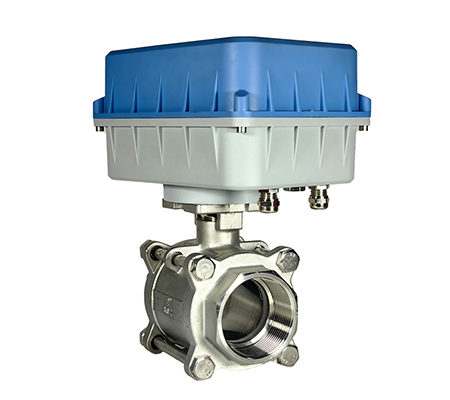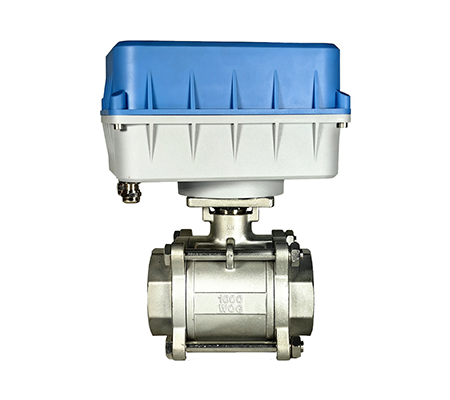Avoid your inquiry is delay response, please enter your WhatsApp/WeChat/Skype along with the message, so we can contact you at the very first time
We will reply you within 24 hours. If for urgent case, please add WhatsApp: +8613188899036, or WeChat: 0531-87968777. Or call 0531-87968777 directly.
* We respect your confidentiality and all information are protected. We will only use your information to respond to your inquiry and will never send unsolicited emails or promotional messages.
Tired of slow, manual valve operation and inconsistent flow? Leaks, wasted energy, and downtime can cripple your system. Switch to an electric ball valve for precise, remote, and automatic flow control—making your operations safer, smarter, and more efficient.
An electric ball valve uses an electric actuator to rotate a ball inside the valve body, allowing or blocking fluid flow. This enables rapid, reliable, and remote-controlled operation for a wide range of industrial and HVAC applications.

Electric Ball Valve for Building Automation and Industrial Flow Control
An electric ball valve combines a traditional ball valve with an electric actuator. The actuator, powered by AC or DC voltage, rotates the ball—opening or closing the port for flow control. This design allows for precise, remote, and automatic regulation of fluid, gas, or steam within pipelines.
“Electrically actuated ball valves are designed for efficiency, safety, and reliability in modern process environments.” — Industry Expert
Where are electric ball valves most valuable? These valves are essential across various sectors:
| Application Area | Key Benefits | Example Use Case |
|---|---|---|
| HVAC | Automated temperature control | Chilled water piping |
| Water Treatment | Lead-free, corrosion-resistant | Potable water supply |
| Industrial Automation | Efficient, remote actuation | Chemical dosing lines |
| Building Management | Energy-saving, full port options | Flow isolation in BMS |
Explore more on smart valve applications and electric valve for water systems.
Manual ball valves are simple, cost-effective, and reliable for basic flow control. However, when you need:
…electric ball valves are the superior choice. Electrically actuated ball valves help automate routine tasks, improve safety, and reduce labor costs. For critical systems where uptime and efficiency matter, upgrading to a motorized ball valve pays off quickly.

Actuated Ball Valve for Automated Process Control
A motorized ball valve features an integrated electric actuator, allowing you to:
This level of automation leads to improved energy efficiency, reduced operational risk, and better system oversight.
See our complete motorized ball valve range and electric actuator options.
Full port electric ball valves have an internal bore equal to the pipe size, allowing maximum flow with minimal pressure loss—crucial for high-flow and critical applications.
Standard port (or reduced port) valves are more compact but restrict flow slightly.
When to choose full port:
Table: Port Types
| Valve Type | Bore Size | Flow Capacity | Common Use |
|---|---|---|---|
| Full Port Ball Valve | Same as pipe | Highest | Main lines, fire safety |
| Standard Port Ball Valve | Smaller bore | Moderate | Bypass, control |
Learn about full port electric ball valves for your specific project needs.
The right size and material ensure performance, durability, and compatibility with your fluid or gas.
Key Factors:
Browse more PVC ball valves and actuated brass options.
Comparison Table
| Configuration | Flow Path | Application Example |
|---|---|---|
| 2-Way | Straight | Isolating a branch circuit |
| 3-Way | L/T Port | Mixing or diverting flows |
| Electrically Actuated | Any | Custom automation |
Choosing the right electric ball valve depends on:
Checklist:
Get guidance from experienced valve distributors and system integrators to guarantee optimal integration.
Pro Tip: Always follow manufacturer recommendations for installation and startup.
See the detailed installation guide for electric valves.
“Routine maintenance ensures reliable operation and extends the life of your electric ball valve.” — Maintenance Supervisor, Industrial Facility
How does an electric ball valve differ from a solenoid valve?
An electric ball valve uses a motor to actuate the ball, offering higher flow and torque for larger pipes. Solenoid valves use an electromagnet and are better for small, fast, low-flow applications.
Can electric ball valves be used for drinking water?
Yes—lead-free brass and stainless steel electric ball valves are certified safe for potable water and food-grade systems.
What is the advantage of a full port electric ball valve?
Full port designs allow unrestricted flow, minimizing pressure loss and making them ideal for high-flow or sensitive applications.
How do I automate a ball valve in my HVAC system?
Choose a motorized ball valve compatible with your BMS or PLC, and wire the actuator to respond to temperature or flow sensors.
What voltage options are available for electric actuators?
Common voltages include DC 12V, DC 24V, AC 110V, and AC 220V. Match your system requirements for safe operation.
Can I retrofit a manual ball valve with an electric actuator?
Many modern ball valves can be retrofitted with electric actuators if they have an ISO 5211 mount. Check manufacturer specifications for compatibility.
Ready to take your flow control to the next level? Contact our team for expert guidance and reliable, energy-efficient valve solutions tailored to your needs.